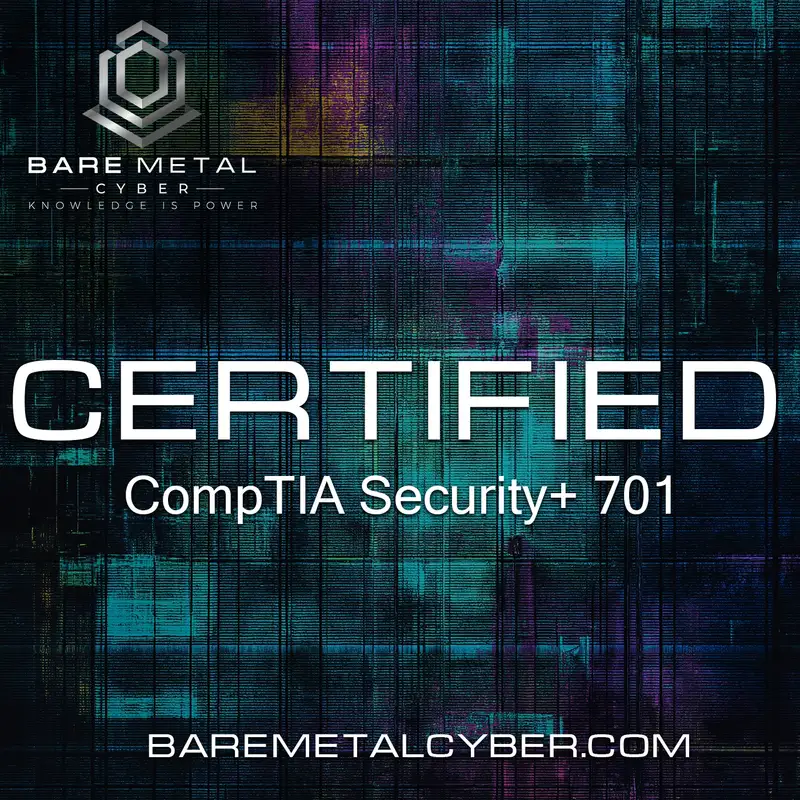All Episodes
Displaying 21 - 40 of 222 in total
Episode 21: Documentation and Version Control (Domain 1)
Documentation is the connective tissue that holds a secure environment together, enabling repeatability, accountability, and informed decision-making across teams and ...

Episode 22: Introduction to Cryptography and PKI (Domain 1)
Cryptography is the bedrock of secure communication, and understanding its principles is essential for every cybersecurity professional. In this episode, we introduce ...

Episode 23: Comprehensive Encryption Techniques (Domain 1)
Encryption is the most widely used method for ensuring data confidentiality, but its implementation must be tailored to the context in which data exists. In this episo...

Episode 24: Cryptographic Hardware and Secure Storage (Domain 1)
Software-based encryption can be effective, but for high-assurance environments, hardware-based cryptography adds critical layers of tamper resistance and performance ...

Episode 25: Obfuscation and Data Protection Techniques (Domain 1)
While encryption is the gold standard for confidentiality, it’s not the only method for protecting sensitive information—especially in use cases like software developm...

Episode 26: Hashing, Salting, and Digital Signatures (Domain 1)
Data integrity and authenticity are two foundational pillars of cybersecurity, and in this episode, we explore how hashing, salting, and digital signatures help uphold...

Episode 27: Advanced Cryptographic Techniques (Domain 1)
Modern threats require advanced cryptographic responses, and in this episode, we explore the techniques that strengthen authentication, protect weak credentials, and s...

Episode 28: Certificates, Authorities, and Management (Domain 1)
Digital certificates are the backbone of online trust, providing the mechanism for authenticating websites, users, devices, and software in a secure, scalable manner. ...

Episode 29: Introduction to Domain Two — Threats, Vulnerabilities, and Mitigations
If Domain One is the foundation of cybersecurity—built on core principles and frameworks—then Domain Two is where we start applying that knowledge to real-world threat...

Episode 30: Understanding Threat Actors (Domain 2)
Cyber threats come in many forms, and to defend effectively, you must understand the adversaries behind the attacks. This episode explores common categories of threat ...

Episode 31: Insider Threats, Organized Crime, and Shadow IT (Domain 2)
Some of the most damaging cybersecurity incidents originate not from unknown hackers, but from within—through employees, vendors, or unmanaged systems operating outsid...

Episode 32: Attributes and Capabilities of Threat Actors (Domain 2)
To effectively model risk and defend systems, cybersecurity professionals must understand not just who the attackers are, but what they are capable of. In this episode...

Episode 33: Motivations Behind Cyber Attacks (Part 1) (Domain 2)
Behind every cyberattack is a motive, and understanding why attackers do what they do is essential for predicting and preventing their behavior. This episode explores ...

Episode 34: Motivations Behind Cyber Attacks (Part 2) (Domain 2)
Cyber threats aren’t always driven by stealth or sophistication—sometimes they are fueled by money, ideology, or ethics. In this episode, we continue our exploration o...

Episode 35: Motivations Behind Cyber Attacks (Part 3) (Domain 2)
Not all cyberattacks are launched for money or politics—some are driven by emotion, chaos, or war. In this episode, we examine three additional motivations: revenge, d...

Episode 36: Introduction to Threat Vectors and Attack Surfaces (Domain 2)
Cybersecurity is not just about knowing your enemy—it’s about understanding the paths they take to reach you. This episode introduces threat vectors and attack surface...

Episode 37: Message-Based and Communication Threat Vectors (Domain 2)
Attackers frequently exploit messaging channels—email, SMS, and instant messaging—to deliver payloads, harvest credentials, or manipulate users into making harmful dec...

Episode 38: Image, File, and Voice-Based Threats (Domain 2)
While emails and text messages are well-known vectors, attackers also exploit images, file attachments, and voice communication to bypass traditional security controls...

Episode 39: Vulnerable Systems, Software, and Devices (Domain 2)
Many attacks succeed not because of advanced hacking techniques, but because of outdated, misconfigured, or unsupported systems that haven’t been properly maintained. ...

Episode 40: Network-Based Attack Surfaces (Domain 2)
Your network is the digital highway that connects everything in your organization—and if not properly secured, it becomes the perfect path for attackers. In this episo...
